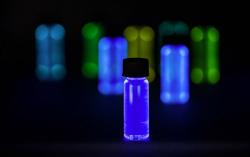Dr. Andreas Haldi was appointed as CYNORA's Chief Marketing Office in 2016. CYNORA develops efficient blue TADF OLED emitters, and Dr. Haldi was kind enough to participate in this interview and help us understand CYNORA's business and technology.

Q: Thank you Andreas for helping us understand CYNORA's business and technology better. CYNORA has set up on a focused mission to develop a commercial blue TADF emitter. What will you consider to be a market-ready material, in terms of lifetime, efficiency and color point?
For the last 5 years, CYNORA has worked on developing thermally activated delayed fluorescent (TADF) OLED emitters. End of 2015 we started to focus on efficient blue materials, which are still a key issue for OLED displays. Compared to the red and green pixels, the blue pixel is much less efficient. An increased efficiency of the blue pixel would therefore significantly reduce the power consumption of the display.
Last year was very successful for CYNORA and we met all of our milestones. We are now on track to reach the performance requested by the OLED industry and the commercialization of our blue TADF material is planned for the end of 2017. Our R&D is progressing quickly, and we expect to introduce a market-ready material by December, with an EQE above 15% and with more than 100h lifetime (LT97) at a typical display brightness and a CIEy color coordinate of
Q: Is a lifetime of 100 hours (LT97) enough for commercial adoption?
At this moment, 100 h at LT97 for the deep blue at high brightness is enough for a commercial device production. The lifetime depends on color coordinate, brightness and other factors. You cannot compare the lifetime of blue pixels with red or green ones directly.
Q: How close is CYNORA to achieving the development of such a material? What are the major challenges still in place?
We are making good progress and we are still in line with our development roadmap, which would have the product ready by December. We have made great progress on lifetime in the last 6 months. In fact, we have already had devices that have surpassed the lifetime of our December target (100h LT97).

While we are quite happy with this achievement in this rather short time of 18 months, we still have some work to do to move our devices towards a deeper blue color. But we are confident that we’ll be able to reach our target with further work on our emitter materials and through strong collaboration with our customers and other material partners who support us in optimizing the OLED devices.
Q: Do you believe CYNORA will be the first on the market to develop an efficient blue emitter? How do you Universal Display and its drive to develop an efficient blue PHOLED?
A deep blue color is very difficult to achieve with phosphorescent technology and this usually goes hand in hand with short lifetime. The blue emitters currently being used, fluorescent emitters, have an acceptable lifetime but for fundamental physical reasons, they are less efficient than phosphorescent and TADF materials. However, our customers urgently need a new approach for efficient blue pixels to reduce the power consumption of OLED displays.
With our TADF technology we can combine long lifetime and high efficiency. The TADF approach will revolutionize OLEDs and we are completely focused on our December goal to deliver a first efficient commercial blue emitter. Due to close cooperation with OLED manufacturers we are sure that the implementation of our first products will run smoothly.
Unfortunately, it is difficult to comment on the status of the competition. A lot of research in the field of phosphorescence science has failed to produce a blue phosphorescent material that combines efficiency, stability, and a proper color point. Universal Display has not presented any new data on their blue PHOLEDs recently, therefore we do not know if and how much progress there is.
Q: Currently all OLED displays on the market use evaporable materials. However it seems that recent advances in soluble based production processes bring solution OLEDs closer to the market, at least for large-area panels. When do you think printable OLEDs will enter the market?
In our opinion, ink-jet printing of OLEDs is long-term 2020 or 2021. It sounds very exciting, and printing methods are becoming more and more advanced, but the technology is not advanced enough yet in terms of uniformity and performance. Nevertheless, we are aware of this technology and we will adapt our materials to the printing process once we have a product for the current evaporation process.
For that reason, last year we signed a Memorandum of Understanding with the Juhua company in China, which is a cooperation platform formed by several Chinese display makers focusing on printing technologies for OLEDs.
Q: Do your materials offer different performance when soluble than when evaporable?
We do not expect any problems with the adaptation to solution processing.
Q: CYNORA is now focused on a blue emitter, but do you also work on red, green and yellow emitters? Do you see a future for non-blue TADF emitters?
A blue emitter is the most challenging material and therefore the race towards this high-efficiency blue is the top priority of all OLED display makers. From our general TADF experience we see that this technology could work for efficient green and red emitters. Nevertheless, we are currently only focused on blue emitters and are very excited about the first industrial tests at the end of this year.
Q: There are several companies and Universities involved with TADF materials. Are there any IP issues in this area? Who owns the basic TADF patents?
In general, the TADF principle has been known for a long time. The first patent families claiming the application of the TADF principle in OLEDs were abandoned and are not active anymore. Therefore, we are confident that we have freedom to operate for our products. But of course, in the end the material patents have the most value in this business anyway, which is why we at CYNORA make sure that all of our materials are patented and that all of our patent applications are free from any dependencies from other patents. We use several IP tools - such as in-depth state-of-the-art searches very early in our development process to avoid such dependencies.
Thank you again for your time Dr. Haldi, good luck to both you and CYNORA!
Comments
Yes JAMF, that was a typo... thanks - fixed!
Typical interview with a marketing officer. Full of bla bla bla... How about an interview with the CTO ?
good CTOs becomes marketing officers when giving public interviews...
Their TADF performance is not even as good as phosphorescent blue. how is it on track to be commercialized by the end of the year? Who is going to use it? What a joke!
Beautiful to see the fast progress of these guys, I remember seeing their presentation at the SPIE some years earlier and again last fall, showing an improvement by many orders of magnitude. From what I know, they surpassed the best GEN 2 "blue" circa half a year ago or so and managed proper blue color point AND efficiency too unlike UDC and BASF based on their published patents and papers.
I wonder if they will really beat Adachi as the inventor of TADF to the market!


Title: are = our ?